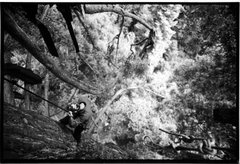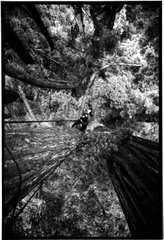
http://www.enn.com/top_stories/spotlight/23154
From: Amy Arcuri and John Griffith, Special to ENN
Published September 18, 2007 11:45 AM
Eureka, California - Daylight and mist chase away the last of the night’s moon shadows, revealing a fern-dominated woodland floor and a forest defined by ancient redwood trees. A sense of peace rains down from the dense canopy in showers of bird song. Centuries have passed untainted in this place. At more than 2,000 years old, Spooner has stood witness over a long era of harmony. Spooner is a redwood that lives in this beautiful grove nestled in the Nanning Creek watershed—a tributary of the Eel River. Spooner, named by those who visit it, is among the last of the unprotected giants. But just two miles away at the Pacific Lumber mill, plans are being made to see Spooner--and his ancient neighbors--chopped down and turned to lumber. The logging has started already at Nanning Creek and will continue again after the endangered marbled murrelets’ nesting season has ended on September 15th. The harmony of the Nanning Creek watershed will soon be replaced by the harsh, off-beat rhythms of chainsaws.
This watershed has already been transformed—many of its pristine features have been hauled away on logging trucks or buried under a stampede of mechanized oxen. Not far from Spooner is an unbelievably tall hill of ash. The mill dumps truckloads of it at the same spot a few times a week. There is a large drainage pool of black water next to this mess. In its natural state there would be frogs and salamanders in this forest pool, but its murky water reveals no life. When the ash is dumped the air turns gray, but the workers are not protecting themselves from the particles. Imagine all the ash when you merely clean your fireplace or wood stove. These men’s lungs must be colored by soot.
The watershed bleeds dirt from the many slides and roads that have washed out. The eroded earth advances towards Spooner’s grove. If you navigate through the mud, slash and stumps, you’ll discover that a piece of the temperate rainforest still remains. It survives because of the efforts of tree sitters and other people who support the struggle to preserve what is rare and ancient. Without them, these trees would only be growing in the memories of those loggers who watched them fall.
The Nanning Creek watershed still has some breathtakingly beautiful old-growth redwoods like Spooner. Some of these trees have been named, too: Jonah, the Cave Trees, the Welcome Tree, Charlie, Belvedere, and on the very outskirts Grandma and Grandpa. These trees are all in danger of being killed. Names won’t save them, but those who named them will try.
The Spooner grove is a glimpse back into ancient times. Spooner is 298 feet tall and has a canopy greater than a thousand square feet. Spooner’s branches are humungous, with some wider than five feet. On these colossal arms live epiphytic ferns, canopy-dwelling salamanders, and many species of birds including spotted owls and marbled murrelets. Various types of mosses, fungi, and lichens flourish in this cloud-grazing garden. Spooner has many reiterations. Reiterations are like extra trunks growing out of the main trunk or other branches. Some people might think they’re suckers, but in a redwood tree reiterations add character and create more microhabitats. Spooner has a triple top. The middle top, at 265 feet, is broken off and still over five feet wide, home to a large huckleberry bush that produces delicious fruit. The other two tops reach even higher. Climbing around Spooner is easy with branches that serve as large pathways for wildlife like flying squirrels—and wildfolk who like to sit in trees. This architecturally unique, massive tree is still growing.
In October 2005, just before timber harvest plan 1-05-097 HUM first began, the Nanning Creek watershed was abundant with springs and creeks. Now many of the springs are washed-out mudslides, and several of the tributary streams to Nanning are inundated by gushes of coho salmon egg-smothering silt.
When an intense logging operation occurs, everything gets trampled and smashed to smithereens under the machinery and felled trees. This happened at Nanning Creek. Wildlife tumbled from branches as trees were cut. The earth shook and rumbled when each giant fell. Rare plants with seldom-seen blooms were smashed under downed trunks. Now this shaded moist place has become drier. A great number of the tall trees that collected fog drip are gone. Tall, fog-scraping redwoods contribute 25–50% of the total water input to their groves each year. And much of that fog drip is provided when water is needed the most—during the summer. Without trees over 200 feet, much less water will enter the Eel River from this watershed. (Nanning Creek is already listed as impaired under the Clean Water Act Section 303(d).)
It is a very sad situation here in Scotia/Rio Dell, California (home to the Pacific Lumber mill). Cutting these trees won’t really help the poor economy. This timber harvest plan is about to reopen. Can we save this ancient grove? Let’s extend this ecological legacy for our children, not create yet another sad story about mistakes made by those who lacked vision and ignored the wisdom of sustainability. The money made by PL’s logging at Nanning Creek won’t help future generations, but the loss of salmon and wildlife habitat and the loss of water for the Eel River will certainly hurt them. Stop the madness and revoke the license to kill the last of the ancients. THP 1-05-097 HUM is a plan of action to destroy 250 acres of redwood—more than 120 acres of this forest is old growth--designated as prime murrelet nesting habitat (category E)! It is the last desperate act from a once-respectable company that’s had financial cancer since the Maxxam Corporation invaded the north coast of California. Pacific Lumber has nicknamed the THP “Bonanza” because they’ll make a lot of money before bankruptcy. But under the current ownership, how much longer will PL loggers and mill workers really have jobs after the few remaining trees like Spooner are cut? How long will it take this watershed to recover from this onslaught? Does the Nanning Creek watershed warrant the time it takes California's residents to ask these questions and understand the long-term consequences of the “Bonanza” timber harvest plan? The answer is “YES!”










